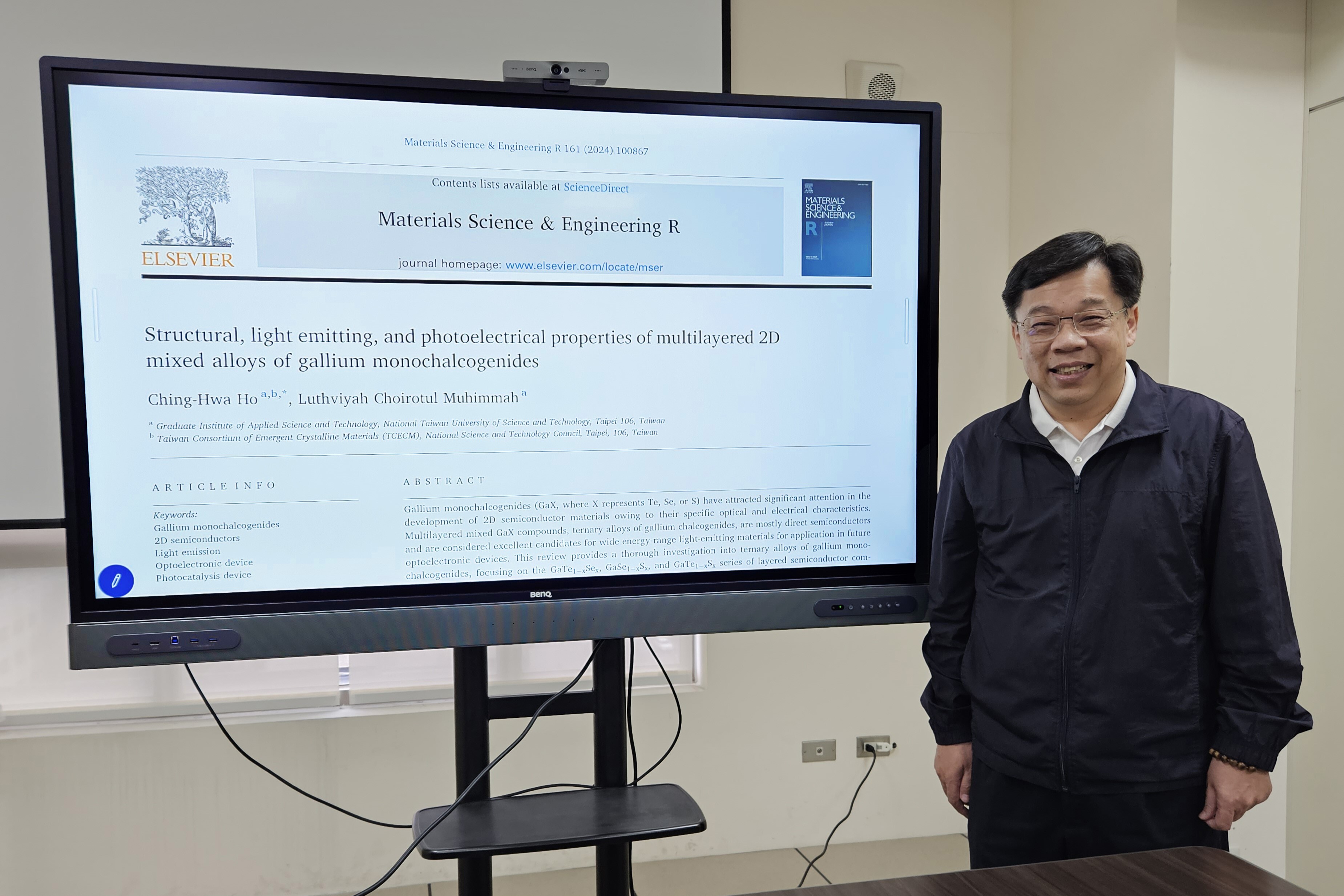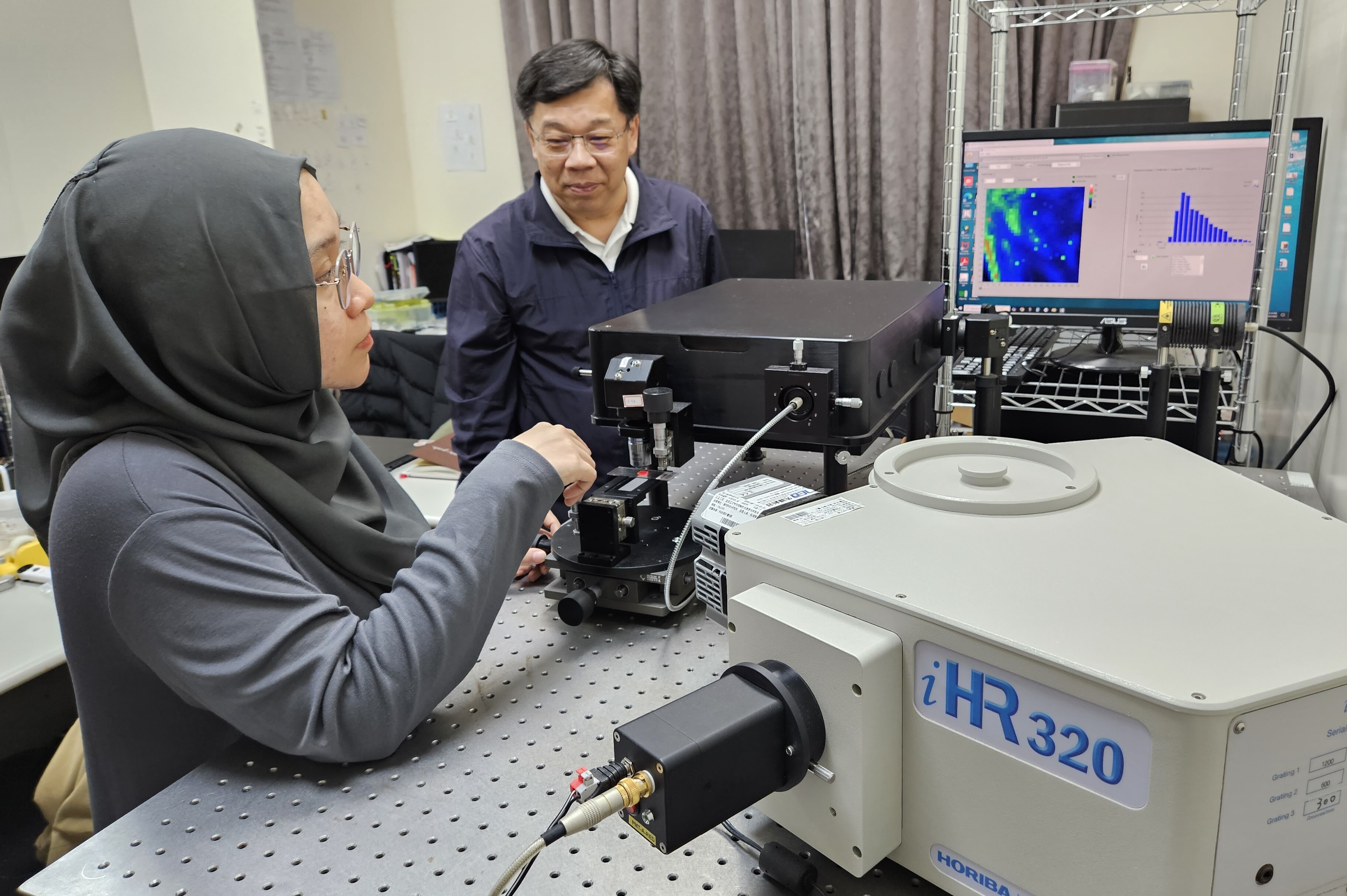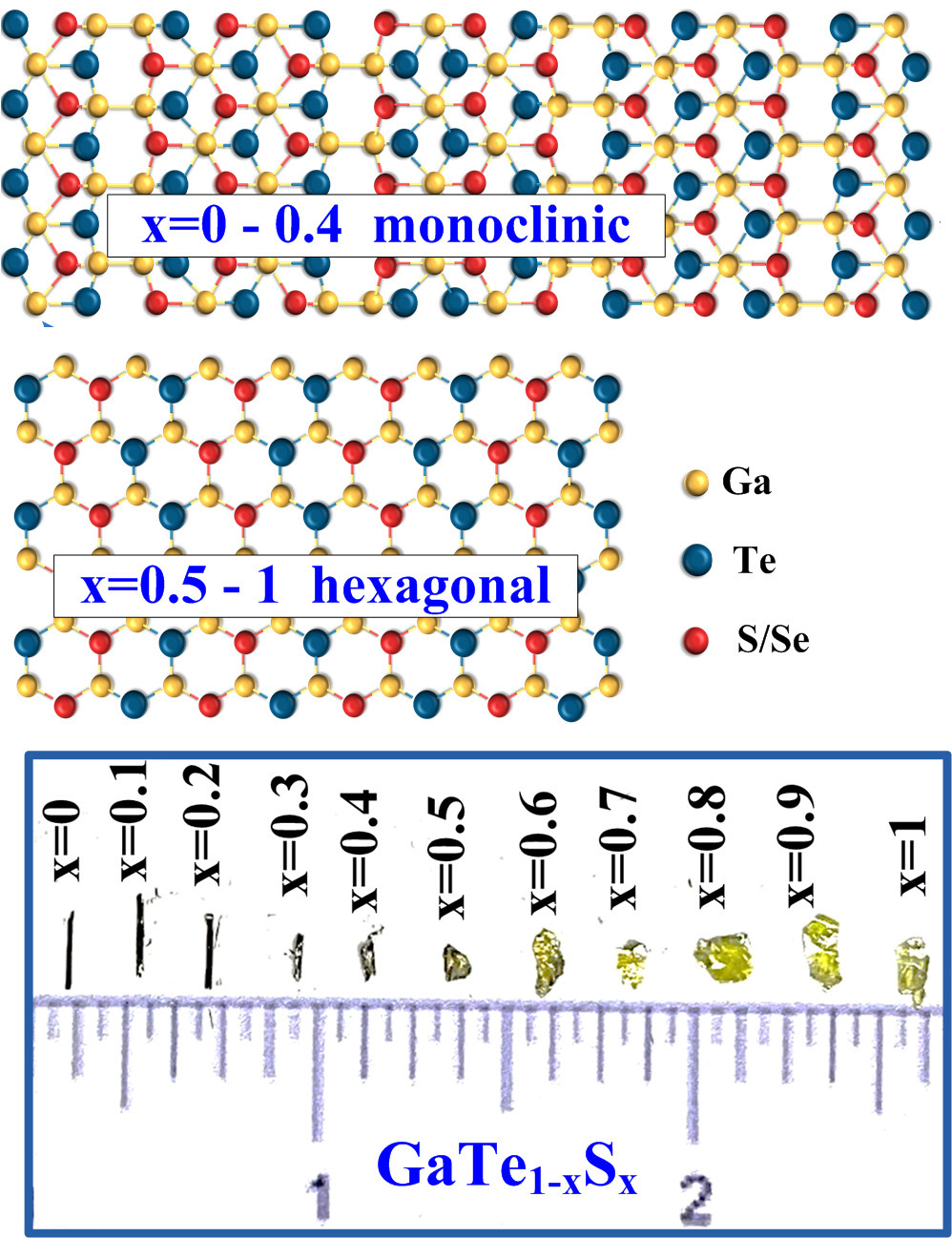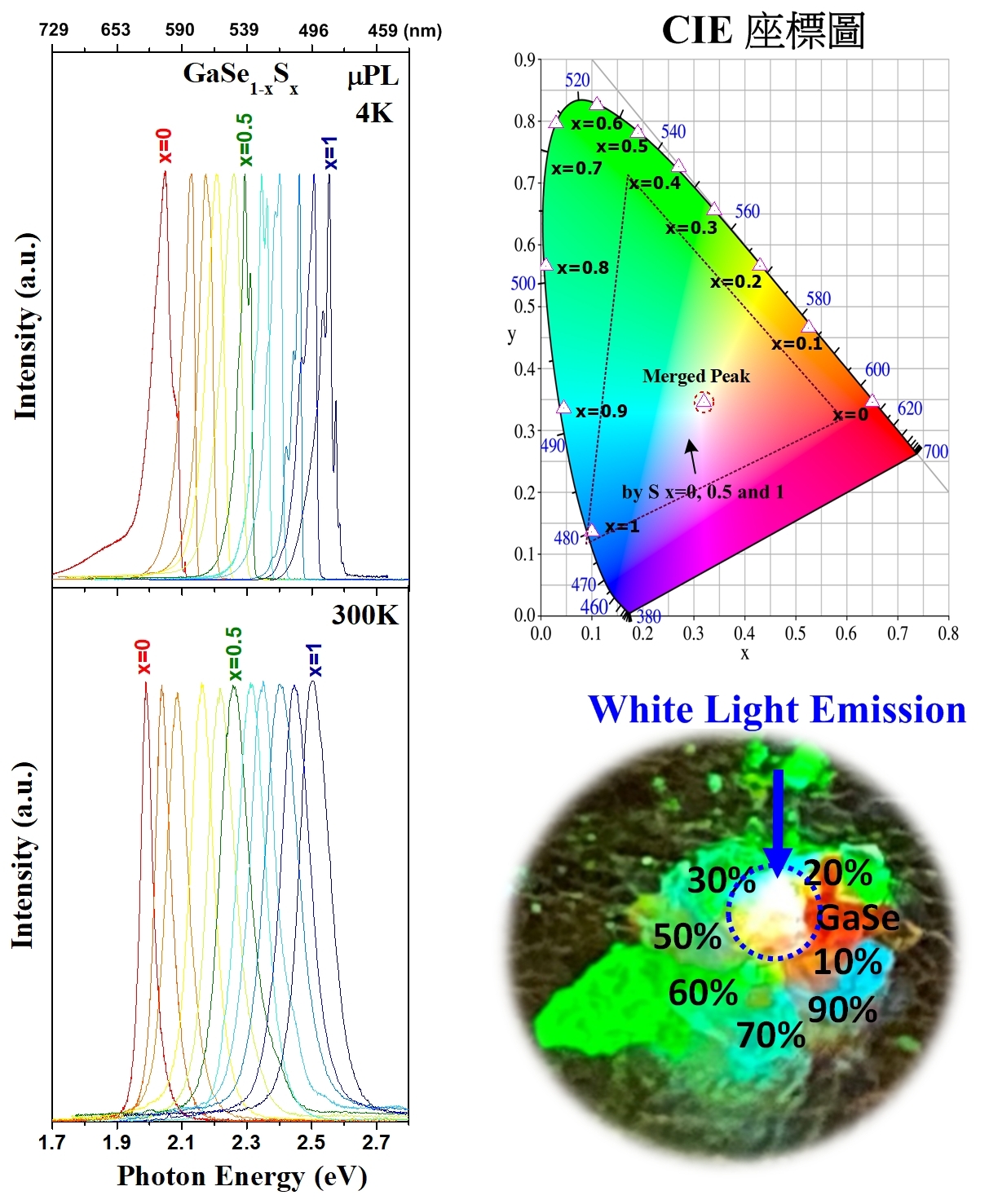Taiwan Tech’s Professor Ching-Hwa Ho’s Team publishes gallium chalcogenide research for next-generation optoelectronics and green energy.
Professor Ching-Hwa Ho, Distinguished Professor at the Gradaute Institute of Applied Science and Technology, Taiwan Tech, has dedicated over 25 years to the study of two-dimensional semiconductor materials. Recently, he integrated his long-term research findings to conduct a systematic analysis of mixed alloys composed of gallium and chalcogen elements, such as gallium sulfide (GaS), gallium selenide (GaSe), and gallium telluride (GaTe). The study explored in depth their preparation methods, crystal structures, and physical properties. Results showed that these materials possess excellent optoelectronic characteristics and hold strong potential for applications in advanced optoelectronic devices such as photodetectors, infrared thermoelectric components, and polarization sensors. They also demonstrate significant promise in green energy and environmental purification fields, including solar energy conversion and the degradation of organic pollutants. The related research results have been published in the high-impact journal “Materials Science and Engineering: R: Reports”.

Professor Ching-Hwa Ho, Distinguished Professor at the Gradaute Institute of Applied Science and Technology, Taiwan Tech, has integrated his long-term research findings to conduct an in-depth study on the preparation methods, crystal structures, and physical properties of mixed alloys composed of gallium and chalcogen elements. The related research results have been published in the high-impact journal “Materials Science and Engineering: R: Reports”.
Gallium (Ga) has long been ubiquitous in modern technology and is one of the key elements in producing high-efficiency luminescent materials, enhancing light-to-energy conversion efficiency. It plays an essential role in light-emitting diodes (LEDs), solar cells, and sensors. Professor Ching-Hwa Ho pointed out that the single-crystal structure of gallium chalcogenides, together with their tunable elemental composition, gives them high plasticity and versatility, making them promising candidates for next-generation optoelectronic materials.
In this study, Professor Ho’s team conducted a comprehensive analysis of gallium monochalcogenides (gallium sulfide, gallium selenide, and gallium telluride) as well as their mixed alloys, such as GaSe₁₋ₓSₓ and GaTe₁₋ₓSₓ. Their research spanned material structures, luminescent properties, and photoconductivity. The results revealed that GaSe₁₋ₓSₓ can achieve full-color emission and white-light mixing, showing excellent and intense photoresponse characteristics, with potential applications in high-efficiency lighting and solar cells. In contrast, GaTe₁₋ₓSₓ demonstrated strong photocatalytic capabilities, making it suitable for solar-driven water splitting for hydrogen production, degradation of organic pollutants, and sterilization, thus providing more efficient new material options for renewable energy and environmental purification.

Distinguished Professor Ching-Hwa Ho of Taiwan Tech and Indonesian postdoctoral researcher Luthviyah Choirotul Muhimmah from the Crystal Growth and Modulation Spectroscopy Characterization Laboratory conducted measurements on the optical properties and carrier lifetimes of two-dimensional semiconductor materials.

Layered crystals of gallium selenide (GaSe), gallium sulfide (GaS), and gallium telluride (GaTe).
The study also pointed out that by doping gallium sulfide (GaS) or gallium selenide (GaSe) with tellurium (Te), the crystal structure can be transformed from a hexagonal phase to a monoclinic phase, producing an in-plane asymmetric axial arrangement. This structural change gives rise to polarized light emission and near-infrared photoresponse, thereby expanding the potential applications of these materials in advanced optoelectronic devices such as photodetectors, infrared thermoelectric components, and polarization sensors.
“Vision is the most direct sense - I like things that emit light!” Professor Ching-Hwa Ho said with a smile. He recalled that as a student, he had been deeply fascinated by gallium-based materials. Although such materials were not a mainstream research focus at the time, their unique optoelectronic properties and future potential strongly attracted him, prompting his resolute decision to pursue this line of research. Now, with research results steadily accumulating and being integrated, he described this paper as a kind of milestone summary, consolidating years of understanding and discoveries on gallium monochalcogenides, with the hope of paving the way for future studies and applications.
He also admitted that academic research often moves ahead of industry. Many materials, even if they perform impressively in academic studies, still face challenges in processing and cost. However, he believes that once industrial demand and technological conditions mature, these seemingly “forward-deployed” research outcomes may bring profound impacts to future technology and industry.

The paper discusses the growth and structural evolution of gallium–chalcogenide mixed alloys. The upper part of the figure illustrates the atomic arrangements of monoclinic and hexagonal crystal structures, while the lower part shows the morphological evolution of GaTe₁₋ₓSₓ crystals with varying compositions. When the composition is closer to the GaTe side (x = 0–0.4), the crystals exhibit a “rod-like” morphology with a monoclinic structure; when the composition approaches the GaS side (x = 0.5–1), the crystals display a “plate-like” morphology with a hexagonal structure.
For many years, Professor Ching-Hwa Ho has led the Crystal Growth and Modulation Spectroscopy Characterization Laboratory, dedicated to developing and producing high-quality two-dimensional semiconductor crystals. For him, the greatest source of motivation to remain committed to teaching and research lies in the sense of fulfillment that comes from his students’ growth and research breakthroughs. Although industry positions may offer better income and conditions, he chooses to stay in academia because of the joy of teaching, mentoring, and exploring the unknown.
Among his students, Yen-Chang Su, currently pursuing a doctoral degree in the laboratory, is another young scholar captivated by the allure of gallium-based materials. Since his master’s studies, he has been engaged in research on gallium selenide, drawn by its exceptional optical properties. He noted that such materials can deliver finer, more accurate color quality and faster response times, with promising future applications in MicroLEDs, display panels, and related technologies. By pursuing a PhD, he hopes to further strengthen his technical expertise and eventually apply his skills to contribute to the high-tech industry.
As optoelectronic materials technology continues to advance, Professor Ho has proposed a number of forward-looking material design and crystal-structure processing strategies, grounded in his long-term research on two-dimensional semiconductors, thereby opening new possibilities for next-generation technologies. Having taught for 34 years, Ho firmly believes that the value of academic research extends beyond the present, laying the foundation for technological breakthroughs ten or twenty years into the future. He also hopes to pass on his passion and accumulated knowledge in materials science to inspire more young scholars, nurturing the next generation of technological talent for Taiwan.

